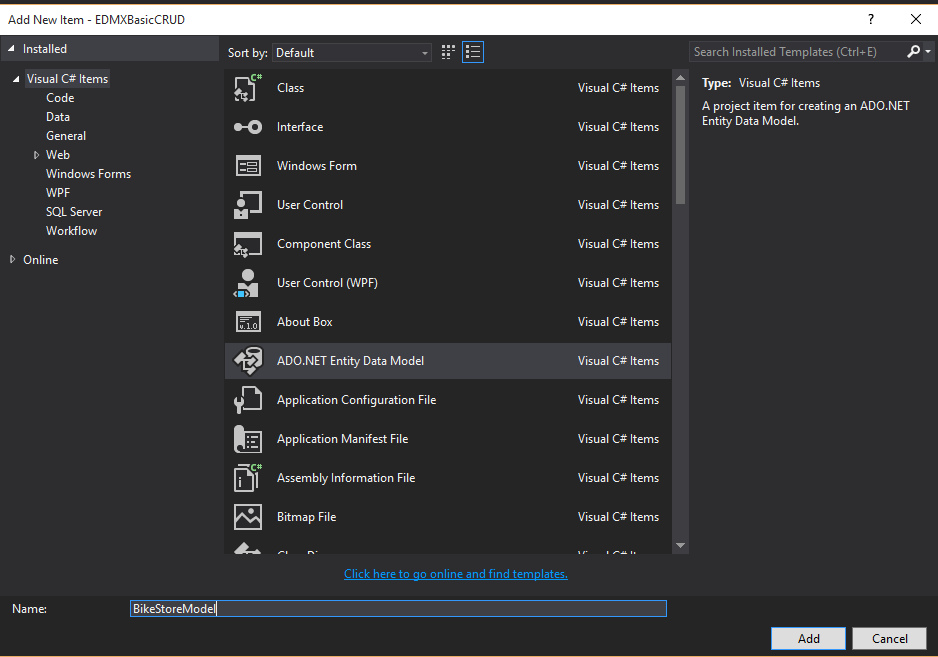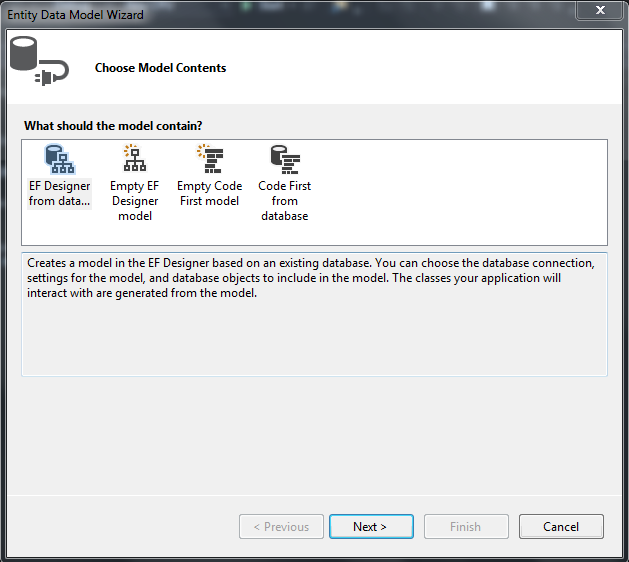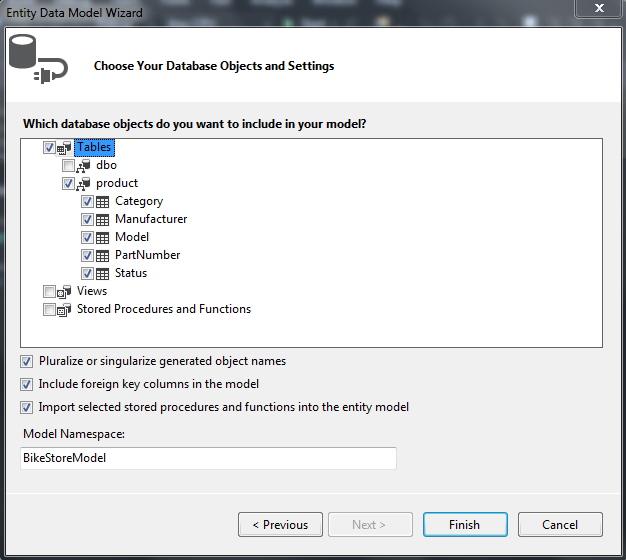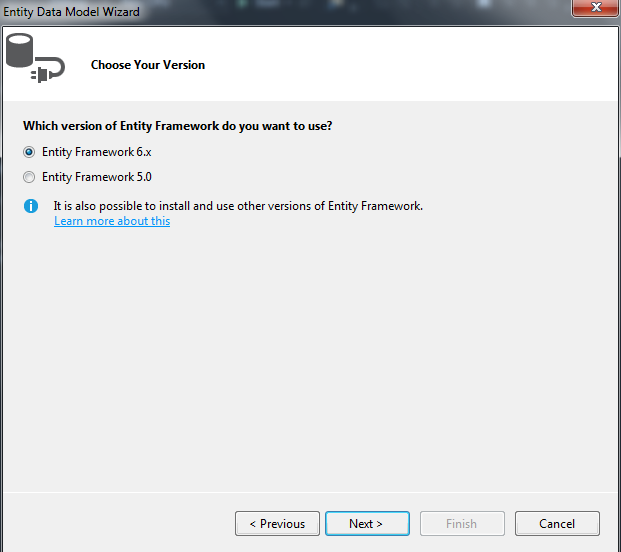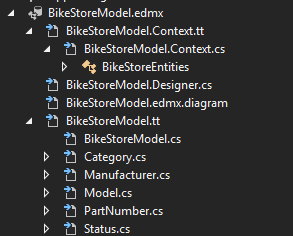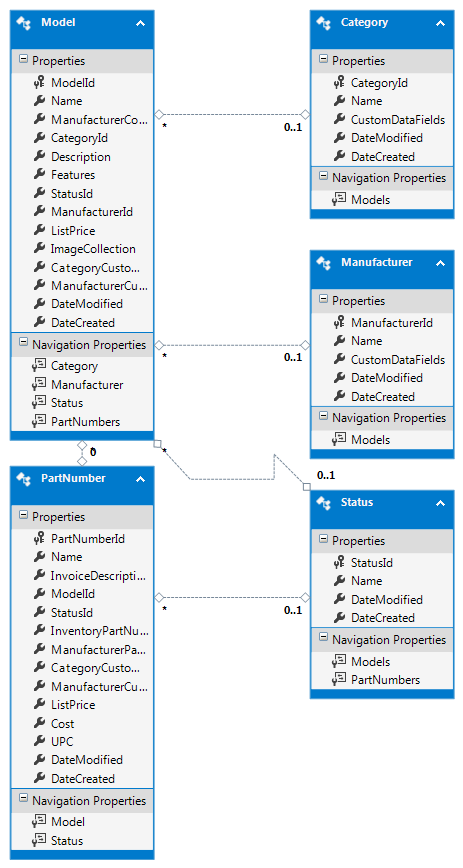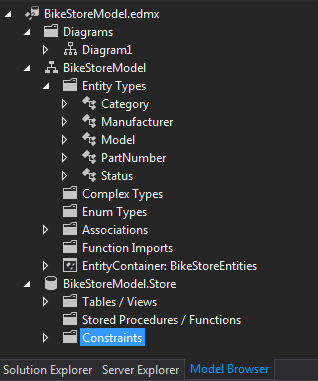As a first of a multi-part series, I am exploring Entity Framework 6.X. My goal is to begin with simple examples, working up to using Entity Framework in a production app. I will explore both the designer/EDMX style, as well as CodeFirst, using Visual Studio 2015. In all cases, I will be focusing on an existing database – the Bike Store database. Apparently the next version of Entity Framework, EF 7, will not include the EDMX/designer option. Because of this, I seriously considered ignoring EDMX all together and focusing on CodeFirst, however A) Microsoft will support EF 6 for many years yet and B) I want to understand the problems EDMX is trying to solve, and see if CodeFirst is a sufficient replacement.
For this first post, we will look at simple CRUD operations using an EDMX model. You can see the full code on github.
Adding the Model
The simplest approach to demonstrate EDMX is using a console application. After creating the project, you’ll need to add a new ADO.Net Entity Data Model:
Choose the EF Designer From database option:
Then choose which tables to bring over (you can add views and sprocs as well – I will cover this in a future post).
Select version 6.X:
With the wizard completed, your project will contain a new .edmx file and a sub-tree containing the POCO classes, context class, templates, and designer files:
Opening the edmx designer, the tables look as follows (after manual positioning):
In solution explorer, if you select the edmx file, a new tab appears that displays a sub-tree of model contents (note this is where sprocs can be added to the model)
Accessing the Model
The first step to using the new entities is to create a database context object. I recommend sticking to the standard practice of wrapping the call in a using block:
using (var db = new BikeStoreEntities())
{
//do database stuff
}
The rest of this post will demonstrate six common data usage patterns:
In addition to the c# code, I will post the generated SQL Profiler trace. (I will write a future post on SQL profiler, but suffice it to say, if you do any serious data work, you need to be using this tool!)
Select Table
using (var db = new BikeStoreEntities())
{
var query = from m in db.Models
orderby m.Name
select m;
Console.WriteLine("All Models in the Database");
foreach (var model in query)
{
Console.WriteLine(model.ModelId + " | " + model.Name);
}
}
SELECT
[Extent1].[ModelId] AS [ModelId],
[Extent1].[Name] AS [Name],
[Extent1].[ManufacturerCode] AS [ManufacturerCode],
[Extent1].[CategoryId] AS [CategoryId],
[Extent1].[Description] AS [Description],
[Extent1].[Features] AS [Features],
[Extent1].[StatusId] AS [StatusId],
[Extent1].[ManufacturerId] AS [ManufacturerId],
[Extent1].[ListPrice] AS [ListPrice],
[Extent1].[ImageCollection] AS [ImageCollection],
[Extent1].[CategoryCustomData] AS [CategoryCustomData],
[Extent1].[ManufacturerCustomData] AS [ManufacturerCustomData],
[Extent1].[DateModified] AS [DateModified],
[Extent1].[DateCreated] AS [DateCreated]
FROM [product].[Model] AS [Extent1]
ORDER BY [Extent1].[Name] ASC
Note that the SQL above is not executed until the query is accessed in the foreach block. This is known as deferred execution. After execution, the result set is kept in memory for further iterations through the loop.
Execute a Filtered Query
A common SQL pattern is joining multiple tables into a custom result set. Native SQL Code is tough to beat here, but we’ll see how Entity Framework does:
using (var db = new BikeStoreEntities())
{
var query = from md in db.Models
join pn in db.PartNumbers
on md.ModelId equals pn.ModelId
join ct in db.Categories
on md.CategoryId equals ct.CategoryId
where md.Name.Contains("tape")
select new { md.ModelId, ModelName = md.Name, PartNumberName = pn.Name, pn.InventoryPartNumber, pn.ListPrice, CategoryName = ct.Name };
Console.WriteLine("All Bar Tape Products in the Database");
foreach (var item in query)
{
Console.WriteLine(item.ModelId + " | " + item.ModelName + " | " + item.PartNumberName + " | " + item.InventoryPartNumber + " | " + item.ListPrice + " | " + item.CategoryName);
}
}
SELECT
[Extent1].[ModelId] AS [ModelId],
[Extent1].[Name] AS [Name],
[Extent2].[Name] AS [Name1],
[Extent2].[InventoryPartNumber] AS [InventoryPartNumber],
[Extent2].[ListPrice] AS [ListPrice],
[Extent3].[Name] AS [Name2]
FROM [product].[Model] AS [Extent1]
INNER JOIN [product].[PartNumber] AS [Extent2] ON [Extent1].[ModelId] = [Extent2].[ModelId]
INNER JOIN [product].[Category] AS [Extent3] ON [Extent1].[CategoryId] = [Extent3].[CategoryId]
WHERE [Extent1].[Name] LIKE N'%tape%'
Not too bad – the linq code is very similar to the generated SQL Code.
Create a New Record
using (var db = new BikeStoreEntities())
{
var model = new Model { Name = "Domane 5.2", ListPrice = 3499.99m };
db.Models.Add(model);
db.SaveChanges();
modelId = model.ModelId;
}
exec sp_executesql N'INSERT [product].[Model]([Name], [ManufacturerCode], [CategoryId], [Description], [Features], [StatusId], [ManufacturerId], [ListPrice], [ImageCollection], [CategoryCustomData], [ManufacturerCustomData], [DateModified], [DateCreated])
VALUES (@0, NULL, NULL, NULL, NULL, NULL, NULL, @1, NULL, NULL, NULL, NULL, NULL)
SELECT [ModelId]
FROM [product].[Model]
WHERE @@ROWCOUNT > 0 AND [ModelId] = scope_identity()',N'@0 nvarchar(100),@1 decimal(19,4)',@0=N'Domane 5.2',@1=3499.9900
Notice the select immediately following the insert operation. Scope_Identity() retrieves the identity value of ModelId for the inserted row. Entity Framework then maps this into the ModelId property of the model reference we added.
Select a Single Record
using (var db = new BikeStoreEntities())
{
var model = db.Models.SingleOrDefault(b => b.ModelId == modelId);
Console.WriteLine("Selected Model:");
if ( model != null)
{
Console.WriteLine(model.ModelId + " | " + model.Name);
}
}
exec sp_executesql N'SELECT TOP (2)
[Extent1].[ModelId] AS [ModelId],
[Extent1].[Name] AS [Name],
[Extent1].[ManufacturerCode] AS [ManufacturerCode],
[Extent1].[CategoryId] AS [CategoryId],
[Extent1].[Description] AS [Description],
[Extent1].[Features] AS [Features],
[Extent1].[StatusId] AS [StatusId],
[Extent1].[ManufacturerId] AS [ManufacturerId],
[Extent1].[ListPrice] AS [ListPrice],
[Extent1].[ImageCollection] AS [ImageCollection],
[Extent1].[CategoryCustomData] AS [CategoryCustomData],
[Extent1].[ManufacturerCustomData] AS [ManufacturerCustomData],
[Extent1].[DateModified] AS [DateModified],
[Extent1].[DateCreated] AS [DateCreated]
FROM [product].[Model] AS [Extent1]
WHERE [Extent1].[ModelId] = @p__linq__0',N'@p__linq__0 int',@p__linq__0=11043
Update a Record
using (var db = new BikeStoreEntities())
{
var model = db.Models.SingleOrDefault(b =>; b.ModelId == modelId);
if (model != null)
{
model.Features = "500 Series OCLV Frame";
db.SaveChanges();
}
}
(excluding SQL generated by SingleOrDefault()
exec sp_executesql N'UPDATE [product].[Model]
SET [Features] = @0
WHERE ([ModelId] = @1)
',N'@0 nvarchar(max) ,@1 int',@0=N'500 Series OCLV Frame',@1=11043
This is quite interesting – the update statement generates a custom list of update fields based on the state of the model. Definitely a situation where auto generation of SQL is useful. Also note that no update statement(s) are sent to SQL Server until db.SaveChanges() is called.
Delete a Record
using (var db = new BikeStoreEntities())
{
var model = new Model { ModelId = modelId };
db.Models.Attach(model);
db.Models.Remove(model);
db.SaveChanges();
}
Many examples have you populate an entity via single select before deleting, but the above approach does generate a select statement before deleting.
exec sp_executesql N'DELETE [product].[Model]
WHERE ([ModelId] = @0)',N'@0 int',@0=11043
Conclusion
These examples demonstrate basic access to a SQL Database through Entity Framework. So far I am impressed with the SQL generation capabilities. The generated SQL is basically the same as I would write if I were writing the SQL manually. A key benefit to writing SQL is using SSMS and testing queries immediately. While this isn’t as easy in Visual Studio, I recommend LINQPad for this purpose. It even pluralizes the entity / table names for you! (category table in database referenced as categories in LINQ)
